March 30, 2020

Looks like we slept in last week.
All of our lives in Ontario have changed profoundly in the wake of the covid-19 pandemic. We’re practicing physical (social) distancing while finding new ways of supporting our friends, family and the broader community. In the process, we’re collectively leaving a fingerprint of how different our lives are becoming – through our hydro (electricity) use.
In the first week of non-essential services being closed, eMERGE Guelph Sustainability analysed the hourly hydro demand compared to the same week going back to 2005. At first the curved and wavy lines look more like a statistician’s dream, but when we dig deeper, the humanity appears to peer through.
Our power demand is on the left side of the chart in Megawatts. The 24 hours of the day are across the bottom. This past week is represented by the red line and is compared to 14 other years.

We use hydro differently for many reasons. Weather and the time of year of course. But also the day of the week and time of day changes the things that we are doing and when. Roll a pandemic into the mix and things appear to change considerably.
Here’s our read of the first week of the lock down. What do you think?
Sunday March 22 – How different should we be acting?
The closing of non-essential services hasn’t kicked in yet. While total demand was considerably lower than average, the actual curve (the time of day that we use electricity) wasn’t that much different. Many people are just getting back from March break holidays and we’re all trying to figure out what’s going on and how it will affect us. Physical distancing is still creeping into our lives but we’re not quite sure about it yet. Most large gatherings and events have been cancelled or postponed. But it’s still a Sunday – so we do things differently.

Typical Sunday hydro use is unique compared to all of the other days of the week. We tend to get up later. Many businesses and manufacturing facilities are closed. We tend to be slow to get going but by the end the day, a crescendo of family and social activities give us a ‘last hurrah’ before the start of the (traditional) work week. This Sunday wasn’t significantly different.
Monday March 23 – Am I going to work or not?
This the first that we see that hydro demand is different. Many of us are not working or working from home. Some businesses have scaled back. The province announced that all non-essential workplaces must be closed by 11:59 pm Tuesday March 24 (tomorrow).
Hydro consumption is lower than average and this is the first that we see of our changing demand curve on the chart. The evening peak demand has been chopped off considerably. And the valley of demand (reduced use) of the middle of the day isn’t as deep. A lot of us are at home and businesses are winding down or cutting back. Most institutions – with the exceptions of hospitals and other health care facilities of course – have not re-opened.
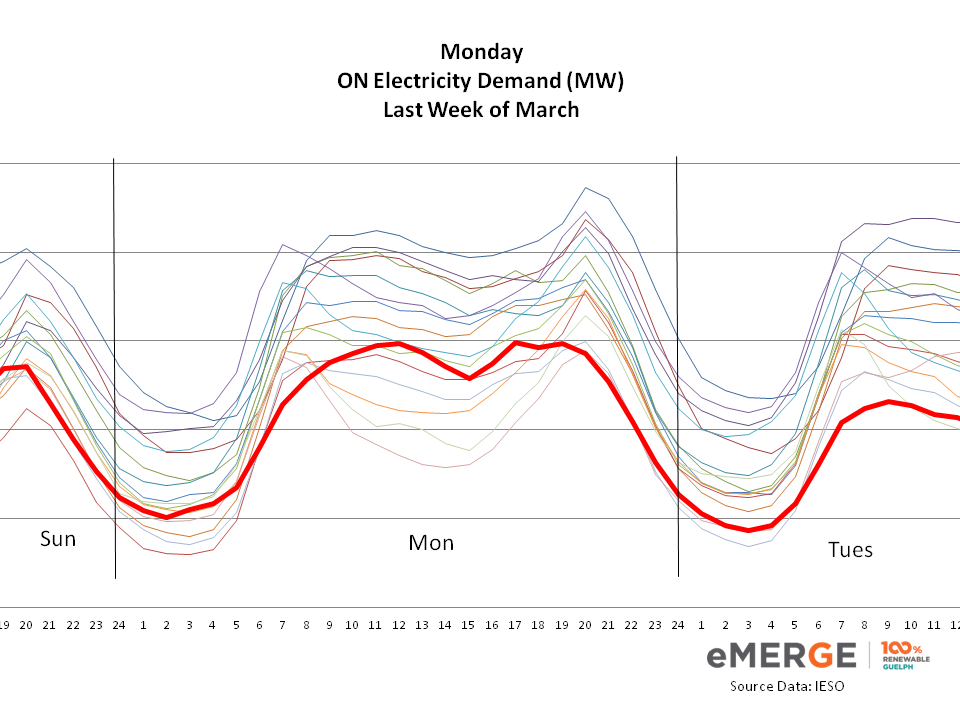
Tuesday March 24 – Honey did you push the snooze button? But I have an 8:30 conference call!
It looks like we slept in today by more than 1 hour – and many businesses didn’t open up as usual. We’re at the early days of figuring out if our home computers have what it takes for video conferencing. Hydro demand for this day is the lowest it’s been over the last 15 years. We appear to be complying with the ‘official’ closure of all non-essential businesses even though it doesn’t come into effect until midnight. How terribly Canadian (but of course we need to do more). Like Monday, we shaved our evening peak hydro demand and our drop in use in the middle of the day isn’t as drastic as other years.
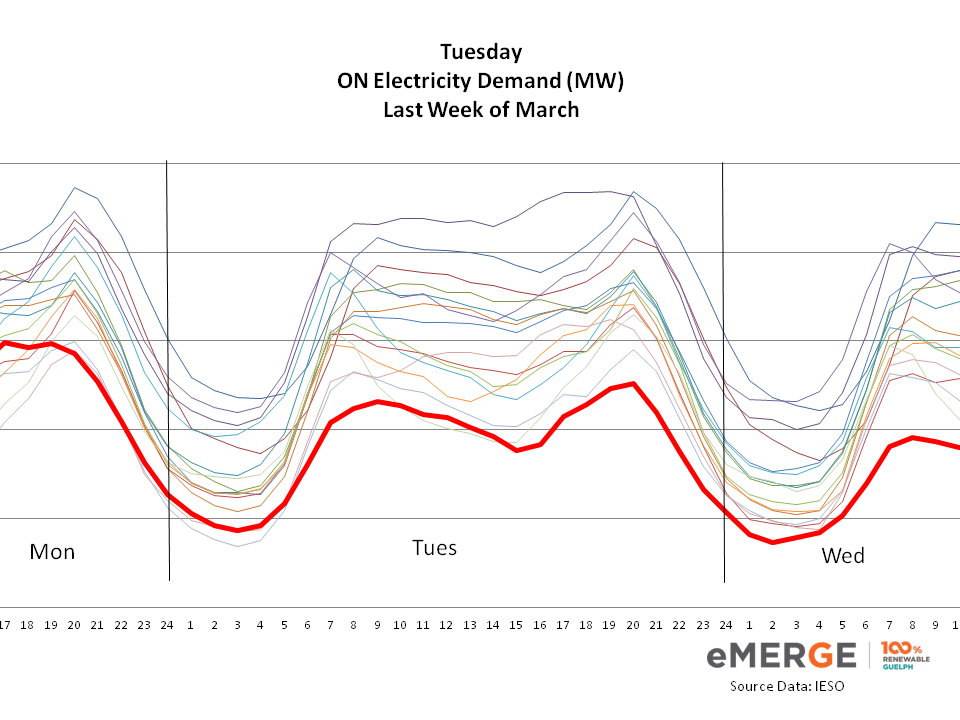
Wednesday March 25 – Forget about the snooze button, you probably slept right through the alarm. Now you have to be in that conference call in your pyjamas.
This is the lowest consumption for this Wednesday in 15 years. And we seem to be moving even slower in the morning. The shape of our power demand today isn’t radically different than the others, but it is ‘hump day’ after all.
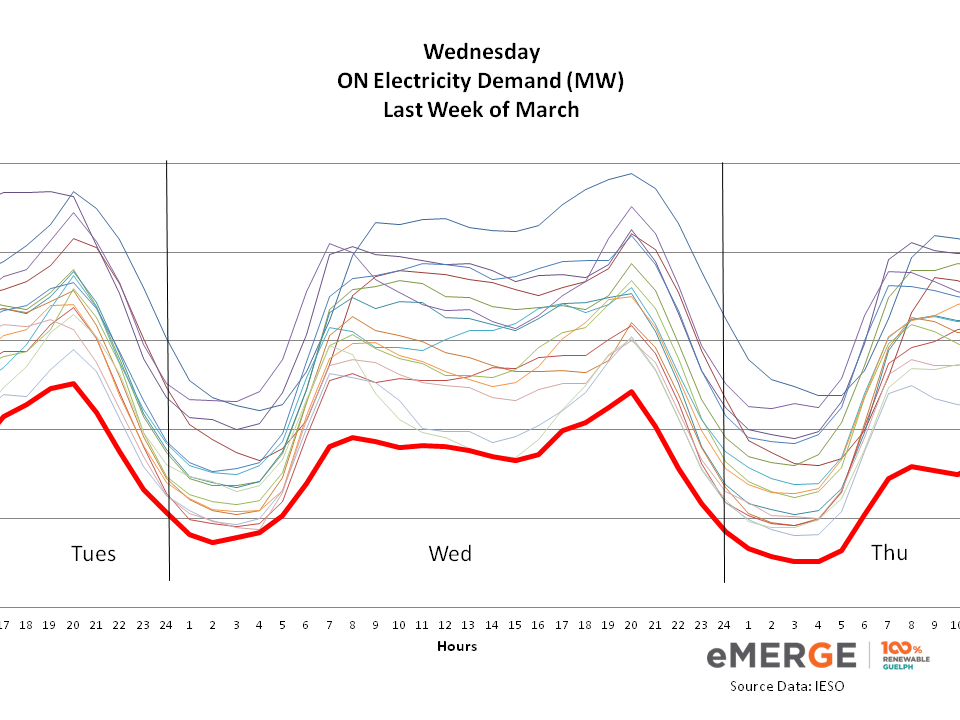
Thursday March 26 – OMG! We forgot to even set the alarm and the kids have been on their tablets for hours? At least we were up before the ‘crack of noon’.
We really had a hard time getting up today. And some of you might have gone for a mid morning nap. Once in motion, we probably had to work into the evening to catch up in the ‘new normal’. Another record low hydro use day and definitely the strangest demand curve for any of the years.

Friday March 27 – We’re gonna get up early if it kills us – you too kids!
We re-bounded a little on our sleeping habits today. Once we got organized, the beautiful spring day enticed us outside for walks or a bike ride – physically distanced of course. The kids have been on their devices way to much this week (and the adults haven’t?). They’re going outside whether they like it or not – (now they have another reason to stay away from that boy down the street because we never did like him anyway).
In fact it seems like a significant proportion of the population went outside in the middle of the day
This was definitely a lower hydro use day, however, some of the other Fridays on the chart were actually a Good Friday Holiday. We appeared to be acting as though this one was a statutory holiday too. That would mean that our hydro patterns are generally different than a typical Friday.
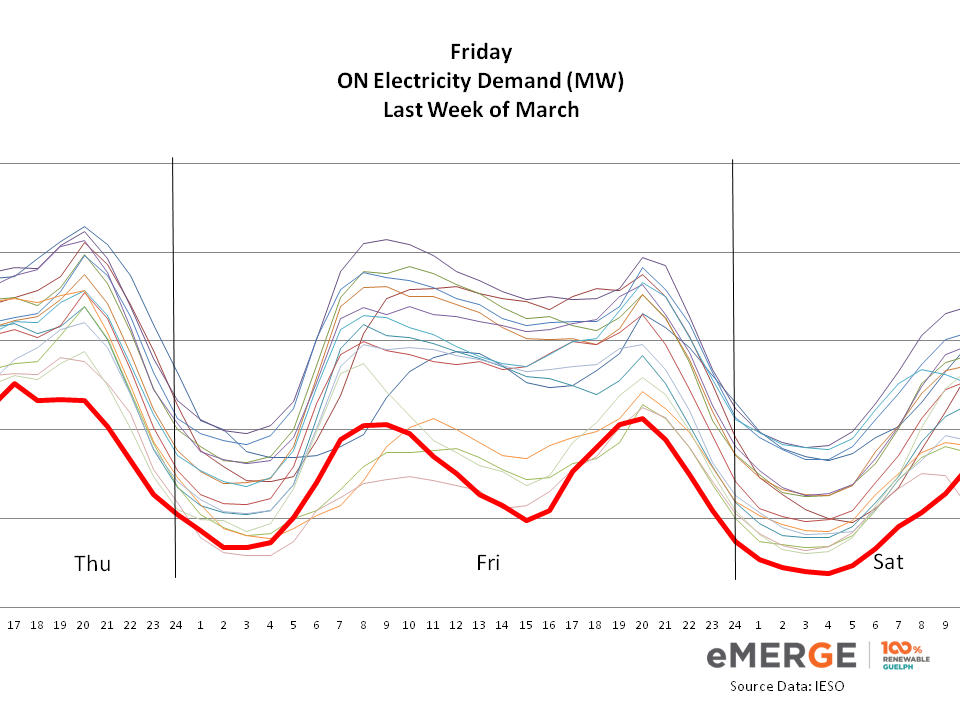
Saturday March 28 – Wow we’re really liking this sleeping in business.
Our Saturdays are usually focussed much closer to home. They’re typically filled with lots of grocery shopping, errands, kids activities, sports, socializing and other leisure activities.
We slept in more than we did for the other days of this week. This time we probably felt we had permission to do so.
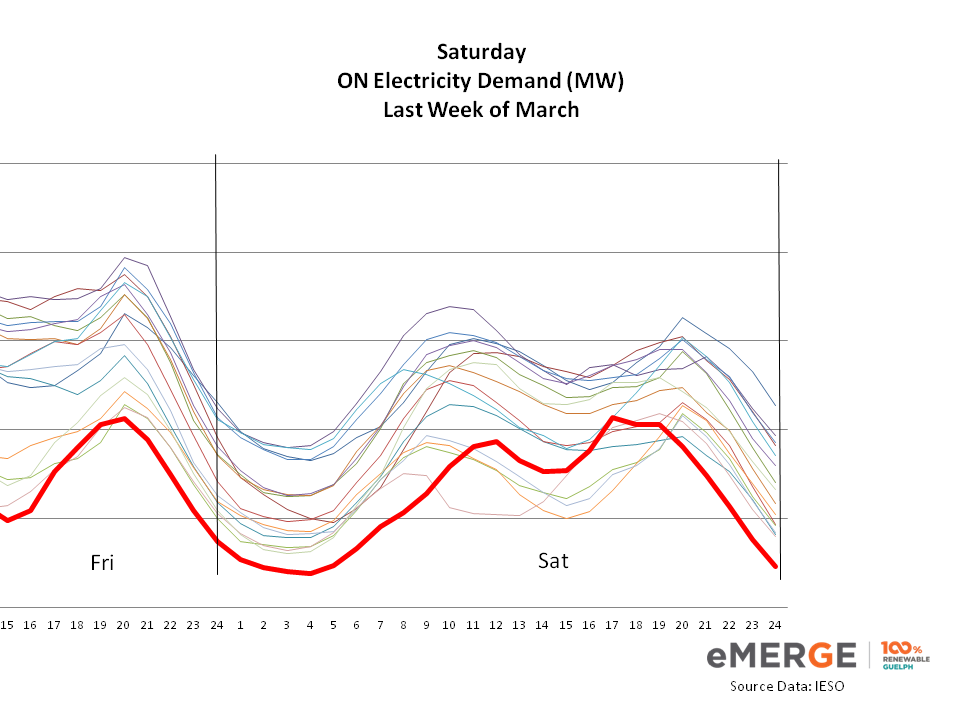
Week Summary
We spent the first part of this week trying to figure things out. In the process we’re using significantly less hydro than we have for the last 15 years, but using it differently. By ‘hump day’ we think we have it all figured out. Thursday trips us because we get up too late for a week day. And by Friday we acted like it was a statutory holiday (and stayed away from that boy down the street too). Saturday gave us permission to sleep in even more but we seemed to go about things somewhat similarly to a regular Saturday.
While our use during waking hours was different, our power demand curve was average in the wee hours of the early morning. That is, our lowest use for each of the days was around 3:00 am – very similar to historic levels.
Ultimately this means that during waking hours, we are doing things significantly different than in the past. If we only had one day this week that was different, we could have passed it off as a an anomaly. But the common elements of significantly lower hydro use at different times of day – the confirms what we already know – our lives have changed profoundly.
In this time of crisis, we also have the opportunity to lessen our fossil fuel use even further and fight climate change, seamlessly. Yes, this has a lot to do with our electricity use.
Here’s how. Ontario mainly only uses fossil fuel – natural gas – for the peak times of day. We still have peaks because we all tend to be doing similar things at the same time. If we choose to do our clothes washing, dishwashing and other electricity intensive tasks off the peak, then we can cut our climate change pollution even further. Our upside-down schedules might help us to do this.
Are we doing enough to fight covid-19? Are we doing it fast enough? How will our lives change over the next week?
Perhaps our hydro use will leave different fingerprints again this week, enabling us to peer behind the curtain again. Check back tomorrow and let’s see.


